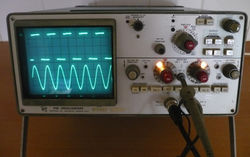432
The Tektronix 432 is a 25 MHz dual-trace portable solid-state oscilloscope.
There is also a rack-mount version, the R432.
Each 432 vertical signal path starts with the coupling switch, then a rotary cam attenuator, then a dual-JFET source-follower buffer amp, then a 155-0050-00 differential amplifier (switched to 155-0050-01 after serial number B239999).
The vertical and horizontal output amplifiers are fully discrete, using silicon bipolar transistors.
Triggering is done by a 4.7 mA tunnel diode that is fed by a discrete trigger amplifier.
The 432 consumes 55 watts maximum and weighs 20 pounds.
P31 phosphor was standard. P7 was also available.
Key Specifications
- please add
Links
Documents Referencing 432
| Document | Class | Title | Authors | Year | Links |
|---|---|---|---|---|---|
| Tekscope 1972 V4 N5 Sep 1972.pdf | Article | Servicing the 432/434 Oscilloscopes | Ken Matheson | 1972 | 432 • 434 |
Patents that may apply to 432
| Page | Title | Inventors | Filing date | Grant date | Links |
|---|---|---|---|---|---|
| Patent US 3562464A | Cam actuated switch having movable and fixed contacts on circuit board | Howard Vollum • Willem H Verhoef • Tony Sprando | 1968-10-07 | 1971-02-09 | Cam switches • 2101 • 2701 • 2703 • 432 • 434 • 465 • 475 • 5A15N • 5A18N • 5A20N • 5A21N • 5A38 • 5A45 • 5B10N • 5B12N • 7A15 • 7A16A • 7A18 • 7A19 • 7A24 • 7A26 • 7B10 • 7B15 • 7B50 • 7B51 • 7B52 • 7B53A • 7B50A • 7B70 • 7B71 • 7B80 • 7B85 • 7B87 • 7B92 • 7B92A • 7D01 • 7D12 • 7D15 • 7J20 • 7S12 • 7T11 • 7T11A • AF501 • AM502 • AM503 • DC502 • DC503 • DC504 • DC505 • DM501 • DM502 • FG501 • FG501A • FG502 • FG503 • FG504 • FG507 • PG501 • PG502 • PG505 • PG506 • PG506A • PG508 • TG501 • SC502 • SC503 • SC504 |
Prices
| Year | 1972 | 1973 |
|---|---|---|
| Catalog Price | $1,585 | $1,585 |
| In 2023 Dollars | $11,700 | $11,000 |
Pictures
-
-
-
-
This shows the area around the BNC input connectors for channels 1 and 2. This photo was taken when the owner was cleaning the vertical gain rotary switches which had become flaky after 45 years.
-
View from the rear. The vertical gain attenuator switches are under the metal covers.
-
When the metal covers are removed, one can see the shaping/compensation capacitors. These can be unplugged, each one has 6 legs.
-
Another view of the shaping capacitors. Work on one channel at a time to avoid mixing these up. Carefully clean the legs with isopropal alcohol and paper towels.
-
In order to access the rotary gain switch fingers, one must first remove these BNC connectors, which means unsoldering the central wire (connects to a resistor/inductor feed-through) plus a debouce capacitor and lead going to the x1 x10 indicator lights.
-
Close up view of BNCs
-
Close up view of BNCs
-
Close up view of BNCs. These need to be unsoldered for removal, but nothing else must be unsoldered to access/clean the vertical gain rotary switch.
-
View of the input preamp. This board needs to be unplugged only, but not removed or unsoldered. It has four 2-pin connectors. Then it can be removed, still attached to the compensation capacitor carriers.
-
Lifting off the assembly consisting of the 2 compensation capacitor carrier plus the vertical preamp board plus the push-button switch board for CH1/CHOP/ALTERNATE/CH2. The switch board has two plug connectors below that must be removed. It helps to have long fingers or a good pair of needle nose pliers.
-
Second view under the assembly being removed.
-
The rotary switches exposed. Each one has four contact fingers underneath. They are cleaned using small (5mm) wide strips of paper soaked in isopropanol alcohol (2-propanol).
-
One can just see the four contact fingers peeking out. You can get paper under them using small tweezers. Patience and calm are required.
-
A view of the variable-gain potentiometers. Note that the bodies are both cracked in the same place. Both had been noisy, but the noise was largely eliminated by sweeping them back and forth a dozen times. That may have scrubbed off the oxide.
-
A view of the contact fingers underneath the capacitor shaping blocks. Each channel has 8 NC and 8 NO fingers (the other half are on the bottom). These are easy to reach and clean as described. So each channel has a total of 20 contact fingers to clean.


















